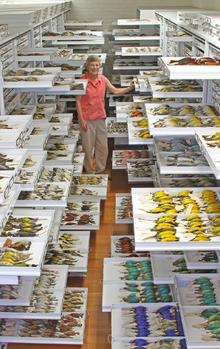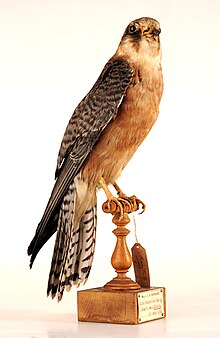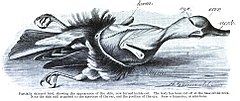Bird collections

Bird collections are curated repositories of scientific
History of bird collections
Origin

The roots of modern bird collections are found in the 18th- and 19th-century explorations of Europeans intent on documenting global plant and animal diversity.[1] It was a fashion to collect and display natural curiosities in Victorian England. Some wealthy cabinet naturalists were able to amass large collections using networks of field collectors. These early collections were not intended for scientific study and the collectors gave importance to aesthetics rather than scientific value.[2] It grew into a more scientific pursuit much later.[3]
Growth

Early scientific bird collections included those belonging to
Collection and preservation techniques

Early specimens represent birds that were pets or came from menageries. The oldest surviving bird specimens include an

Techniques to preserve birds were attempted even from the early 16th century as shown in the writings of

A more recent preparation method pioneered by the
Uses of bird collections
Bird collections are used for a wide variety of purposes. All biological species including those of birds are represented by a holotype, the vast majority of which are full specimens (mostly skins) and in modern times explicitly designated in the original description of the taxon. All other putative members of the species may be compared to the holotype to confirm their identification. Rigorous studies of avian taxonomy are based on specimens from bird collections. Taxonomic studies rely on morphological and genetic characters to determine species limits and evolutionary relationships. Museum specimens have been the preferred source for scoring these characteristics, as they allow studies to be replicated – anyone may go back and repeat the study using the same specimens to verify the conclusions. However, it has alternatively been argued that such re-examination can be undertaken from archived photographs without killing the study piece.[26]

In the case of molecular studies, the preservation of a specimen that can vouch for the source of the tissue sample used to gather genetic data has been recommended, as genetic analysis often yields surprising results that make reexamination of the original specimen crucial.[14][27][28]
Studies on ectoparasites, usually obtained during capture, but also obtained from old museum specimens, are valuable for studies on coevolution and zoonoses.[29][30]
In addition to taxonomic research, collections can provide information relevant to the study of variety of other ornithological questions, including
Bird collections have been useful for retrospective studies. Bird collections offer the potential for current and future researchers to make in-depth morphological and molecular study of past avian diversity. One of the earliest and most famous examples of this was the use of egg collections from the 19th and early 20th centuries in determining that the pesticide DDT was producing eggshell-thinning in raptors.[35][36][37] The ornithologists who collected the eggs could never have known that their work would one day help establish causes for declines and help in making conservation strategies to save bird such as peregrine falcons from possible extinction.
As threats to bird populations grow and extinctions continue, historical specimens are valuable in documenting the impacts of human activities and causes of decline for threatened species.[38][39][40] Bird collections have also been used to gauge the flow of environmental pollutants over time. A study of soot deposits on specimens collected within the United States Manufacturing Belt was used to track concentrations of atmospheric black carbon over a 135-year span.[41] Other possible uses for bird specimens not known today may arise in the future.
Collection debates
The issue of whether birds should continue to be actively collected for research has been the subject of some debate among ornithologists (examples of this can be found in the lively exchanges between Remsen[42][43] and Bekoff & Elzanowski,[44] between Vuilleumier[45][46] and Donegan,[26] and between Dubois & Nemesio[47] and Donegan[48]). Those opposed to collecting believe that much of current collecting is unnecessary, arguably motivated by the personal field scores of individuals or by competition between museums, rather than the result of a strict scientific rationale; that collecting, in extreme cases of species on the verge of extinction, can pose a threat to bird populations; and that in many cases in which the necessity of specimens is claimed, new technology such as digital photography and blood sample analysis of mist-netted individuals could instead be used. Finally, at a time of rampant deforestation and species extinctions, scientists and conservationists should take the lead in providing an example to local people not to kill or hunt birds. Where other techniques not involving killing of a bird are feasible, to take a specimen is viewed by some as simply unethical.[26][44] Proponents of collecting counter-argue that compared to the many millions of birds killed each year by habitat destruction, domestic cats, window strikes, and tower kills,[49] scientists collect only a few thousand birds per year worldwide and populations will quickly recover from an episode of collecting as long as their habitat remains.[42][45] Supporters of continued collecting also point to the greater scientific utility and legacy of museum specimens compared to blood samples or photographs, and argue that collecting for research offers the only source of avian mortality with a positive outcome for birds in terms of the biological knowledge gained.[28] Although taking small blood samples from wild birds is often viewed as a harmless alternative to collecting, it reduces survival by as much as 33%[50] and does not provide the benefits of a voucher specimen.[28] Scientists have pointed out that bird populations represent renewable resources, and that scientific collecting represents only a tiny and non-additive proportion of annual bird mortality.[14][42][51] However, examples exist of species whose extinction was directly contributed to by museum collecting (e.g. Guadalupe caracara,[52] ivory-billed woodpecker[53]). The last bird of the extinct Black Mamo from Molokai was shot for collecting.
References
- ISBN 0385125747.
- ^ .
- ^ ISBN 0691036322.
- ^ Sharpe, R B (1835). The history of the collections contained in the natural history departments of the British Museum. Volume 2. London: British Museum. pp. 79–90.
- ISBN 9780812221046. p. 97
- S2CID 83849594.
- .
- .
- JSTOR 20020347.
- .
- ISSN 0040-9480.
- .
- ^ Reed, C.K. & C.A. Reed (1914). Guide to taxidermy. Worcester, Mass., C.K. Reed. pp. 22–23.
- ^ .
- S2CID 37630485.
- S2CID 143260391.
- ISSN 0261-0523.
- S2CID 191989601.
- ^ S2CID 86281124.
- ISSN 0260-9541.
- ^ Blake, E. R. (1949). Preserving birds for study. Fieldiana: Technique no. 7.
- ^ Dickerman, R.W. 1989. Schmoo preparation. Pp. 7–11, in S. L. Rogers and D. S. Wood, eds. Notes from a workshop on bird specimen preparation. Section of Birds, Carnegie Mus. Nat. Hist., Pittsburgh, Pennsylvania.
- ^ Sirois, P. Jane (2001). "The analysis of museum objects for the presence of arsenic and mercury: non-destructive analysis and sample analysis" (PDF). Collection Forum. 16 (1–2): 65–75.
- .
- S2CID 86411950.
- ^ a b c Donegan, T.M. (2000). "Is specimen-taking of birds in the Neotropics really "essential"? Ethical and practical objections to further collection" (PDF). Ornitologia Neotropical. 11 (3): 263–267.
- PMID 11020311.
- ^ S2CID 5957433.
- ^ Oniki, Y. (2002). "Another value of specimens in museum collections" (PDF). Ornitologia Neotropical. 13 (3): 323–324.
- ^ Health Protection Agency (2006) Investigation of specimens for ectoparasites Archived September 27, 2007, at the Wayback Machine. National Standard Method Issue 1.
- ISBN 0521485290.
- ^ Rasmussen, P.C. (2005). "On producing Birds of South Asia" (PDF). Indian Birds. 1: 50–56. Archived from the original (PDF) on 2012-03-06.
- S2CID 85900573.
- .
- S2CID 4175038.
- S2CID 11317338.
- .
- S2CID 86454486.
- S2CID 146795.
- .
- PMID 29073051.
- ^ .
- .
- ^ .
- ^ a b Vuilleumier, F. (1998). "The need to collect birds in the Neotropics" (PDF). Ornitologia Neotropical. 9: 201–203.
- ^ Vuilleumier, F. (2000). "Response: Further collecting of birds in the Neotropics is still needed" (PDF). Ornitologia Neotropical. 11 (3): 269–274.
- .
- .
- ^ Sibley, D. A. Bird Conservation — Mortality Archived September 28, 2007, at the Wayback Machine. sibleyguides.com
- S2CID 86726894.
- ^ Banks, R. Human related mortality of birds in the United States. Washington, D.C.: Special Scientific Report, Wildlife, No. 215, U.S. Fish and Wildlife Service.
- JSTOR 1363459.
- ISBN 0-374-36173-8.
External links
- American Ornithologists’ Union Committee on Bird Collections
- ORNithological Information System (ORNIS)
- Type-specimens in 3D
- Extinct specimens in 3D (National History Museum of the Netherlands — Naturalis)
- Museum handbook
- Inventory of major European bird collections
- F.D. Steinheimer The whereabouts of pre-nineteenth century bird specimens Zool. Med. Leiden 79-3 (5), 30-ix-2005, 45-67.— ISSN 0024-0672.
- ebeac electronic index of bird collections
